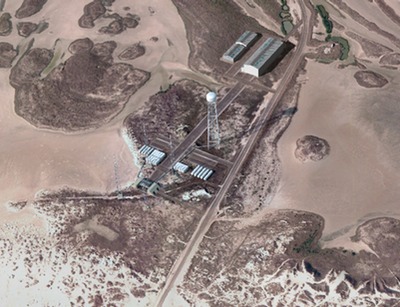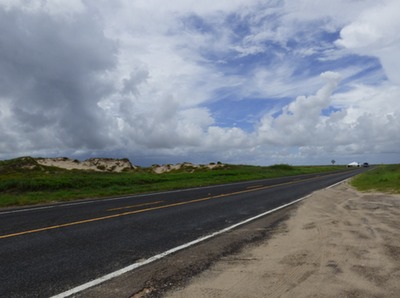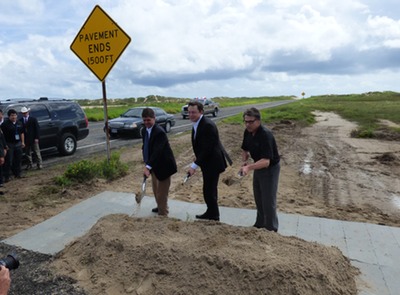A highway’s ending is a spaceport’s beginningby Jeff Foust
|
| The end of Highway 4 will soon be marked not just by the warning signs, but by a 21st century outpost: a commercial launch site. |
Then, finally, there are the signs: “PAVEMENT ENDS,” they warn. There are a series of them, providing a countdown to the highway’s end: 1500 feet, 1000 feet, and 500 feet. Just after that last sign, sand from the dunes the road cuts through starts to mix with the asphalt, along with sand tracked onto the road by vehicles driving off the beach onto it. There is no parking lot, intersection, or barrier to mark the highway’s end, only those series of signs and the end of the pavement, a sudden end muddled by the sands of a largely deserted beach.
In a few years, however, that scene at Boca Chica Beach will change. The end of Highway 4 will be marked not just by the warning signs, but by a 21st century outpost: a commercial launch site. Last month, SpaceX formally agreed to site its commercial launch complex there, and formally broke ground on it during a September 22 ceremony there.
As groundbreakings go, it was a routine event. Buses ferried guests and media, almost all local, from Brownsville to the site, with a tent set up in view of one of those “PAVEMENT ENDS” signs. Dignitaries gave speeches, then posed for the traditional groundbreaking photos, shoveling sand from a pile set up just behind the podium.
While the event was routine, what the event was for was not. After years of courtship, Brownsville and the greater Rio Grand Valley had finally convinced SpaceX to establish a launch site there. For SpaceX, it means a launch site it will have full control over, allowing it to shift commercial satellite launches it currently performs from Cape Canaveral. For the region, and the state, it’s a step towards solidifying themselves as a major player in what they hope to be a growing, and lucrative, industry.
“We thank you for having the vision to see that this is where you needed to be, wanted to be,” said Texas Governor Rick Perry in a speech at the groundbreaking, offering those thanks to SpaceX CEO and chief designer Elon Musk, siting on the dais next to him.
Musk had, for some time, made it clear that this site—variously referred to as the Boca Chica, Brownsville, or South Texas launch site—was his preferred location for a commercial site. While the company looked at other options, including Space Florida’s proposed Shlioh site just north of the Kennedy Space Center as well as options in Georgia and Puerto Rico, Musk strongly hinted that Texas was the company’s preferred location.
“If things go as expected, it’s likely that we’ll have a launch site in Texas,” Musk said in a March 2013 keynote presentation at the South by Southwest festival in Austin, Texas. That comment came a day after he appeared before a committee of the state legislature there, asking for legislation to support those plans. That included a bill passed later that year that would allow SpaceX to close the beach at Boca Chica during launches, an exception to the state’s open beach policies.
The final details fell into place this summer, when the Federal Aviation Administration’s Office of Commercial Space Transportation (FAA/AST) completed an environmental impact statement of the proposed launch site. Building the spaceport would have various affects on the environment, but the study concluded they could be mitigated.
“I have determined that all practicable means to avoid or minimize environmental harm from the alternative selected have been adopted,” wrote FAA associate administrator George Nield in a “record of decision” about the proposed launch July 9, giving his approval form an environmental standpoint for any future launch licenses or permits for launches there.
 A illustration of SpaceX’s launch site at Boca Chica Beach, Texas. (credit: SpaceX) |
Less than a month later, Perry announced that SpaceX had agreed to locate its launch site there. “Texas has been on the forefront of our nation's space exploration efforts for decades, so it is fitting that SpaceX has chosen our state as they expand the frontiers of commercial space flight,” he said in the August 4 statement announcing the deal.
The deal includes some economic incentives as well. The state government is providing $15 million to support the spaceport’s development, primarily to the Cameron County Spaceport Development Corporation, a local agency, to help develop infrastructure needed for the spaceport. Local agencies are also providing a similar amount in the form of funds or tax abatements.
The bulk of the funding to actually build the spaceport, though, will come from SpaceX itself. “In the three- to four-year timeframe, we expect to spend on the order of about $100 million,” Musk said of SpaceX’s investment in the Boca Chica site. “In the long term, if you go out, say, 10 or 20 years, it’s probably in the several hundred million dollar range.”
| “We’ll do some advance work here in Boca Chica, but we’ll probably start more significant activity in the third quarter of next year,” Musk said. |
Musk didn’t say what those additional long-term investments would entail. In the near term, the site will consist of a single launch pad for SpaceX’s Falcon 9 and upcoming Falcon Heavy launch vehicles, a vehicle processing hangar, propellant storage and other support facilities, and a control center a few kilometers to the west.
While SpaceX broke ground last week, work on the spaceport won’t begin in earnest until at least the middle of next year. In an impromptu press conference Musk held after completing a series of groundbreaking photo opportunities with attendees, he said the company is currently focused on renovating Launch Complex 39A at the Kennedy Space Center. SpaceX signed a deal with KSC earlier this year to take over maintenance of the site and use it for Falcon 9 and Falcon Heavy launches.
“Once we are finished with the upgrades on Pad 39A, we’re going to take our development team and immediately move them to Boca Chica to work on the launch site here,” he said. “We’re expecting the Cape site to be done in approximately nine months.”
“We’ll do some advance work here in Boca Chica, but we’ll probably start more significant activity in the third quarter of next year,” he added.
Under that schedule, the first launch from Boca Chica could take place as soon as late 2016, Musk said. “Our preference is to move the commercial GTO [geostationary transfer orbit] missions to the Boca Chica launch site as soon as we can,” he said, citing the benefit from launching slightly closer to the Equator (the site is at approximately 26° north latitude, compared to about 28.5° for Cape Canaveral.) Moving those launches from the Cape would also help reduce schedule pressures on the Cape, where SpaceX shared the range with the Atlas V and Delta IV rockets.
Musk reiterated that while SpaceX wants to move commercial satellite launches from the Cape to Texas, other launches will remain in Florida. Those will primarily be government launches, both of satellites for the military and NASA and commercial crew missions to the International Space Station. SpaceX is renovating Pad 39A specifically for handling commercial crew launches it won earlier this month.
Musk, though, wouldn’t rule out using Boca Chica for human spaceflight. “I would expect commercial astronauts, private astronauts, to be departing from South Texas,” he said.
SpaceX’s plans, be they for satellites or human spaceflight launches, are music to the ears of local officials and the general public. They hope SpaceX’s presence will help support science, technology, education, and mathematics (STEM) education projects in the region; one such project, at a local university, will involve work at the spaceport. It will also be a source of jobs, both with SpaceX itself and with companies that will be supporting the spaceport’s construction and operations.
| “I know the sign behind me says ‘Pavement Ends,’” Perry said, “but the future of South Texas takes off right behind me.” |
Locals even see the tourism prospects of the spaceport, drawing people to see as many as 12 launches a year. South Padre Island, a resort community about 10 kilometers up the coast from Boca Chica, may offer the public some of the best views of launches from the site, and businesses are taking note. “WELCOME SPACE-X [sic] TO SPI!” read the sign on one business on the island’s main drag.
After the groundbreaking, attendees returned to Brownsville for another round of speeches by local officials, thanking the various individuals involved with luring SpaceX to the area. Some hoped that the effort will help build more of an identity for the region, rather than as a collection of towns.
 The current appearance of the Boca Chica launch site. The white tent in the background hosted the groundbreaking ceremony. (credit: J. Foust) |
“I’ve long criticized the ‘Football Friday’ mentality of the Rio Grande Valley,” said state representative René Oliveira, referring to rivalries between communities that played out both in high school football games and elsewhere. Those rivalries, he said, were set aside in the quest to bring SpaceX to the area. “I have never seen such a united effort.”
The Brownsville area isn’t the only part of Texas taking an interest in commercial space. On September 17, FAA/AST awarded a commercial launch license to Midland International Airport in support of future suborbital flights there by XCOR’s Lynx suborbital vehicle. The airport—now called the Midland International Air and Space Port—is the first licensed spaceport in the state (Blue Origin’s test site in West Texas is not licensed since it’s exclusively for the company’s use, and an FAA spokesman said last week that a license for the Brownsville site had yet to be submitted.)
Last Friday, Firefly Space Systems announced it had received a $1.2-million grant from an economic development authority in the Austin suburb of Cedar Park, Texas, to establish offices there, with testing facilities planned for the nearby town of Briggs. Firefly, which is developing a small launch vehicle (see “Small satellites, small launchers, big business?”, The Space Review, August 11, 2014), said in its statement that’s interested in launching from Brownsville or elsewhere on the Gulf coast of Texas.
Last Monday, though, was all about Brownsville and SpaceX, where the end of the highway is seen as a beginning for something bigger. “I know the sign behind me says ‘Pavement Ends,’” Perry said, pointing to one of those signs located in view of the podium, “but the future of South Texas takes off right behind me. And that’s what today is really all about.”
